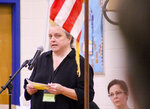




On Monday, 198 Essex residents passed measures to fund all financial operations, including the FY25 annual regional school district and municipal budgets. But it was changes to the town’s zoning bylaws and the future of the aging Essex Elementary School building that took up most of the evening’s public discussion and debate.
The business of the Town Meeting Warrant’s 31 articles were taken up quickly, in just over two hours. The first ten articles were approved by voters within 15 minutes, including the Essex FY25 $9,351,174 General Budget and a series of water and sewer related DPW expenditures.
School District Supported
Articles 11, 12, and 13 were school district-related, and the ME School Committee took no risk in introducing them. School Committee Chair Theresa Whitman defended the board’s choice to finalize and present Essex’s $9,889,756 share of the $31.1 million FY25 operating budget for the ME Regional School District, which represents a 2.9% increase over last year.
The district budget could have come in slightly lower, but the committee approved the current one, which includes $64,000 for two part-time teaching assistants, which Whitman said was a responsible choice for students.
“We are an outlier,” said Whitman, commenting on other school districts in Massachusetts that average 3.9% in budget increases this year while MERSD's . She nodded to success with union negotiations, which she said were transparent and collaborative. She also said MERSD won’t feel the financial loss of Covid funding because the district was responsible and used the funds for actual Covid-related expenses instead of general operations. Other districts didn’t, she said, and now suffer for that decision. In the end, the budget is financially sound.
“We appreciate good value,” Whitman said.
Then a potential spoiler. Antonella Muniz of Harlow Street suggested that the entire FY25 MERSD district budget article was moot since, according to Massachusetts state law, school budgets require passage by a two-thirds majority of the School Committee. MERSD’s passed by a 4-3 approval, she said.
Town Moderator Jeff Jones asked Muniz what she was seeking in her comment. Muniz demurred, stopping short of moving to recall the article.
Then Town Administrator Brendhan Zubricki stood up and said the vote should continue, and if anything was required by state law it would be reconciled later.
Whitman said that of the three school committee member votes against the 2.9% budget included one member who supported a larger district operational spend, which by inference, would mean the budget presented at town meeting was supported by the required number of school committee members.
Article 12 passed easily, as did Article 11 seeking $345,545 for the town’s share of the Essex North Shore Agricultural and Technical School District.
Essex Elementary Building
Article 13 stirred animated discussion seeking $336,050 as Essex’s contribution to an estimated $1.5 million feasibility study on the future of Essex Elementary School (EES). Whitman said the EES project was formally activated by the Massachusetts School Building Authority (MSBA) earlier this year, triggering a two-year window to formally study the project or lose grant funding that would defray 30% of the cost. She urged voters to support the article.
“There's no use playing ‘chicken’ with this building,” Whitman said.
The study was greeted with a sense of sticker shock by many in the room.
Pam Beaudoin, MERSD superintendent, said that was understandable but assured those at town meeting that “study” is something of a misnomer. The project would onboard an entire building team, including architects, a project manager and specialists who will deeply review and cost out all conceivable options for the EES, including renovation, changing school formats (K-2, K-5, etc.), new siting options, shutting down EES entirely, and, yes, rebuilding a new school building in its current address.
Ben Buttrick, former chair of the Finance Committee, said data is needed to determine the future of the Essex Elementary School building, and the study would provide that data. Further, he said, the Essex FinCom had supported the expenditure unanimously, and recommended residents follow suit.
“Vote ‘YES’ really loud,” implored Annie Cameron, former school committee member in her remarks. And, whether or not it was in response to Cameron’s plea, the vote came in loud and clear: Article 13 passed quickly, and unanimously.
So Much Zoning
It was then Lisa O’Donnell, chair of the Essex Planning Board’s turn. She introduced the board’s seven articles on the annual town meeting warrant regarding proposed changes to the current Essex zoning bylaw.
The Planning Board began its steady march to “recodify” the Essex Town Bylaws governing land use three years ago, and have been working with the support of outside consultants at the state’s Metropolitan Area Planning Council (MAPC). The idea has been to introduce small changes and chip away at shaping Essex’s zoning, which until three years ago allowed permitted uses—residential, commercial, retail, and industrial—anywhere. The board has been able to do this under the protection of a temporary moratorium preventing residential-to-commercial changes in use.
In the last several town meetings, the PB has successfully created Essex’s first “districts”—the Downtown District, two residential districts, and the rest of Essex falls under the General District (comprised of 98% of townlands).
But Monday’s ATM may have felt like a change in pace for voters. O’Donnell presented a wide-reaching series of articles, taking up 22 pages in the meeting guide. She said the changes were designed to add clarity and detail to provide stronger protections for residences and businesses.
O’Donnell said the changes are needed. So far it’s been Essex’s limited ability to access public sewer hookups and perks that have protected Essex from unwanted development, she said.
But these protections are tenuous. The changes to the bylaw, O’Donnell said, would “protect the character” of Essex. She emphasized that special permitting process, which allows review by the Planning Board and includes impact of neighbors, would ensure that the Essex resident have come to know and love will stay that way.
Collectively, the PB’s articles addressed dimensional changes in the Essex Downtown District (Article 14); Article 15 addressed updating the purpose and intent of the town’s entire zoning bylaw; Article 16 added a section unlimited and permitted uses; Article 17 added general provisions to special permits, a process reserved for uses that are allowable in town, but are not permitted “by right.” Article 18 updated the special permit for cell phone towers, otherwise known as personal wireless service facilities; Article 19 addressed special permit use for adult entertainment, which is protected by state law under freedom of speech laws; Article 20 added uses that required a special permit.
Ed Neal of Western Ave. disagreed with O’Donnell, strongly. He said the entire slate of Planning Board articles would irrevocably alter the very core of what makes the Essex character what it is: opportunity without meddling from local government. He said the new bylaw changes were more about the agenda to overregulate small towns by the state’s Metropolitan Area Planning Council, which Neal called “the handmaiden of the (Massachusetts) Legislature.”
Neal warned voters that excessive regulation would obstruct local small businesses like his, and it would make the Planning Board a large, powerful force that could go unchecked.
“These would be limiting to the beginning of a new business and the expansion of existing ones,” Neale said. If Essex voters supported the Planning Board’s articles, “we’d be cutting our own throats.”
Neal’s pleas fell on deaf ears. All Planning Board article passed by the required two-thirds majority, easily and without the need for a recount.
Other business passed at town meeting included: